… Ah,
Ambrosia
Oystering in Winchester Bay
Story and photos by Lee Juillerat
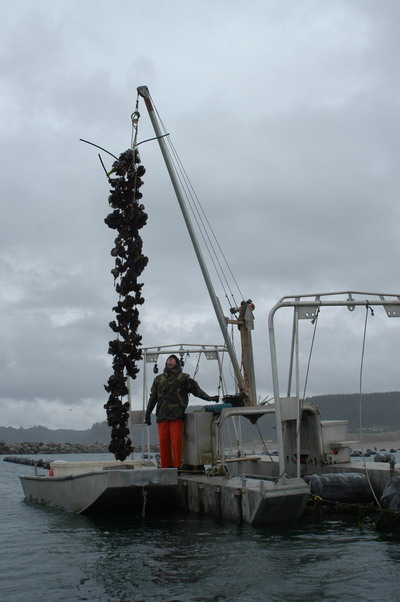 |
People have been clammoring, or oystering, for the delicious morsels for centuries. The ancient Greeks regarded oysters as ambrosia and envisioned Aphrodite, their goddess of love, "springing forth from the sea on an oyster shell and giving birth of Eros, from which the word 'aphrodisiac' was born.” It’s said that Roman emperors paid for oysters by their weight in gold, and sent thousands of slaves to shores along the English Channel to collect them. And, according to legend, Casanova, the legendary lover, whetted his sensual appetite by slurping 50 oysters during his daily morning bath |
|
|
Hang 'em High
|
The plate in front of me displayed five, not 50, large oysters, languidly sitting on five glowing half-shells. Minutes earlier Cindy Sardina, the owner of Winchester Bay’s Umpqua Aquaculture, had grabbed a handful of oysters, plied the shells open, washed them with a spray of water and set the oysters in the cleaned shells. "Go ahead," she instructed. "Enjoy."
No problem. I love fresh oysters. I’ll try to dissuade others from eating them – “Most people break out in hives,” I warn, garbling while stuffing down one after another. I first tasted them in the Chesapeake Bay, on Maryland’s Eastern Shore, freshly harvested by skipjacks, boats used by crews, or tongers, small boats worked by a single oystermen.
Raw is best. But lightly fried in a special flour mixture, or heated over a
campfire just long enough that the shell opens without prying, or, as Sardina
taught me, in a simple to make but simply delicious stew.
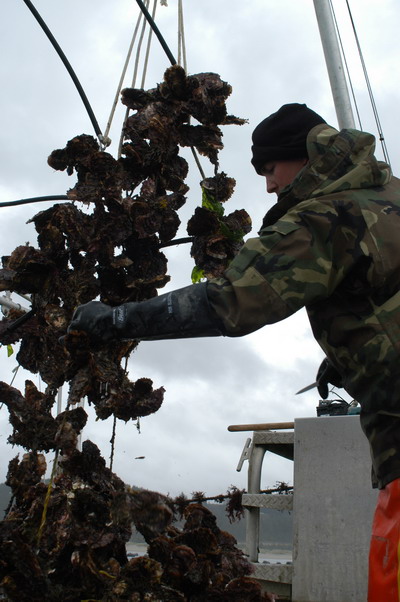 |
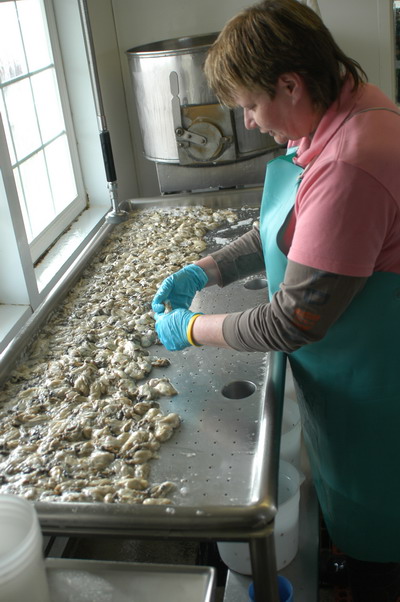 |
|
The Pearl District
|
Final Cleaning
|
Umpqua Aquaculture is a place where oyster lovers mingle in an unpretentious building at the harbor in Winchester Bay, a friendly town along the central Oregon Coast. The oysters are kept in a refrigerated display that proffers oysters of various sizes - yearling, extra small, small, medium and large - in pint or quart containers. You can also request “shooters,” oysters on the half-shell. Just like the ones Sardina prepared, they’re nabbed from the pile, pried open, shucked and served.
During my first visit, a father and daughter readying for a long drive back home bought a platter of a dozen oysters on the half-shell, poured them down their throats, then drove off. Less than a half-hour later they were back, clammoring, or oystering, for more. "We figured it's not too often we get oysters as fresh and delicious as these," the father explained, quickly scooting outside so that his daughter didn’t get an extra share of their second dozen.
Oysters are regarded an extremely healthy food. Nutritionally, they contain proteins, carbohydrates and lipids, and are high in omega-3 fatty acids and low in cholesterol. They're also regarded an excellent source of vitamins A, B1, B2, B3, C and D, and have high mineral contents of iron, copper, iodine, magnesium, calcium, zinc, manganese and phosphorus.
Winchester Bay’s oysters grow in an area known as the Triangle, a protected
30-acre triangular breakwater near the place where the Umpqua River coalesces
with the Pacific
Ocean. The oysters are grown, or farmed, on suspended rope curtains that bob
up and down with the tide over the two to four years takes to grow a harvestable
oyster from seed in water that consistently stays at 51 degrees. If connected,
the network of 15- to 30-foot long rope curtains would measure nearly two miles.
Sardina says the mix of cold ocean tides and clean river water helps in producing
"clean, sweet, pearlescent meats.”
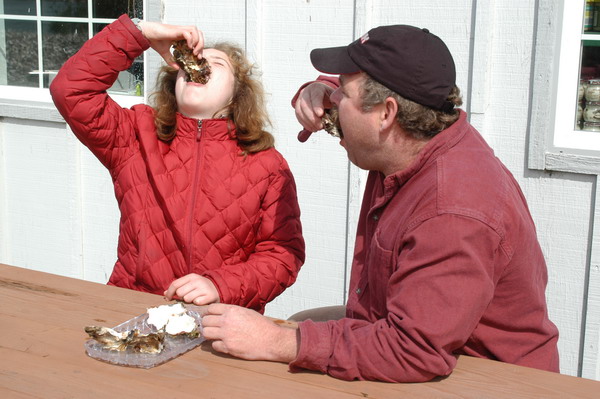 |
|
|
Tossing 'Em Back
|
Shucking the Day Away
|
Most days one of Sardina’s employees drives a small boat loaded with a pair of totes to a customized barge in the Triangle. The curtains, each weighing about 150 pounds, are mechanically lifted and swung over the totes. A knife is used to slice oysters from the float line and, if the harvester’s aim is good, the shells noisily cascade into the container. Other days used shells attached with tiny seeds of oysters-to-be to guarantee future harvests. After the totes are filled, the oyster-laden boat returns to the shore, is put on the trailer and driven to the plant, where the load is refrigerated until a day or two later when they whapped open, shucked and separated by size and packed into containers.
"The curtains prevent our oysters from ever coming in contact with the muck at the bottom of the bay,” Sardina explains. “Oysters traditionally grown in beds are exposed to air at low tide and to mucky sediment when submerged.” Adult oysters, she says, daily pump seven or more gallons of water through their systems, which means the diets of bedded oysters include large amounts of sediment that can result in a more pungent taste. Along with the taste, she claims the sediment affects the color of oysters.
While few people see the work the Triangle, other steps in producing oysters
can be seen at the processing facility, where large windows offer views of the
shucking and sorting processes and a video shows and explains the seed to shell-to-store
process. Most of the oysters are collected into large containers, which are
spilled onto a sorting table, where they are sorted and sized into pint and
quart containers as yearling, extra small, small, medium or large. Packaged
oysters are sent in refrigerator trucks to nearby North Bend, where they're
flown to Chicago and other distant markets or prepared at Oregon Coast in restaurants
in Winchester Bay, Reedsport and Florence. Casanova, the Romans and the Greeks
never had it this easy.
 |
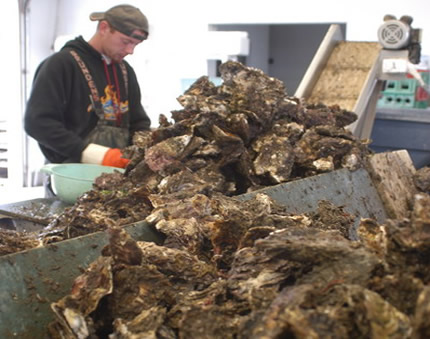 |
|
Taxi to the Table
|
A Long Day's Work
|
If You Go…
For more about Umpqua Aquaculture, visit their Web site at www.umpquaoysters.com
or call (541) 271-5684. The staff is often busy so expect to leave a message.
In Winchester Bay, the production facility, which includes a sales are that
offers a large selection of sauces and condiments, is located at 723 Ork Rock
Road.
About the author…
Lee Juillerat is a writer-photographer for a newspaper in Southern Oregon. He
also does freelance writing and photography for a wide variety of newspapers
and magazines. He can be contacted at lee337@cvc.net.
Umpqua Triangle Oyster Stew
1/4 chopped onion
1/2 finely diced carrot
1 tablespoon butter
salt and pepper
1/8 cup flour
1 quart oysters
1/2 gallon milk
1 clove garlic
Saute onion in butter until yellow. Add chopped garlic and carrot.
Cook until tender. Add flour to thicken and liquid from oysters.
Cook, adding milk if needed. Add oysters. Cook until oysters are
plump, then ad milk. Salt and pepper to taste.
Deb Howard's Birthday Barbecue Oysters
Clarify together: 1/4 pound butter, 1/2 lemon, 3 cloves minced
garlic.
Mince, fry crisp and drain: 8 ounces maple flavored bacon
Lightly blanch small head fresh chopped spinach
Open on barbecue and leave on the half-shell: 2 dozen medium oysters
in the shell
Garnish with teaspoon spinach, teaspoon bacon, teaspoon butter mixture
Grill on barbecue for 2 minutes more.
Spinach and Oyster Quiche
1 9-inch pie shell
1 pint extra small oysters
1 10 ounces package frozen chopped spinach (well drained)
1 cup shredded cheddar cheese
3 large eggs
1 cup milk
1/2 pound bacon crisp pieces
Parmesan cheese
In a 9-inch pie shell, layer well drained spinach, oysters and
cheddar. Mix together egg and milk. Pour into the pie shell. Sprinkle
the bacon bits and Parmesan over the top. Bake in a 450 degree oven
for 15 minutes, lower temperature to 350 degrees and bake for another
35-40 minutes or until a knife inserted into the egg mixture comes
out clean. Set another 5 minutes before serving.
Lee Juillerat writes for the Klamath Falls Herald and News in Southern Oregon
and is a freelance writer-photographer for several magazines, including Northwest
Travel, Oregon Coast, Range and in-flight magazines for Horizon and Alaska Airlines.
He can be contacted at lee337@cvc.net.